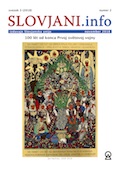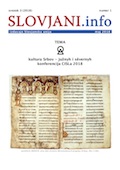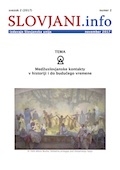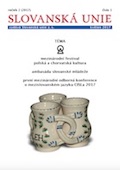

parametry poiskanja: avtor = %Steenbergen van, J.%, nazvanje = %, rezjume = %, kljucno = %, od = 2016, do = 2999
(novo poiskanje jest na na koncu tutoj stranice)

PDF format |
Silfer, G., Steenbergen van, J. Slovjanske vlivy v Esperanto (in English: Slavic influence to Esperanto) in: Slovjani.info, 2018, 3(2), pages 13-16. ISSN 2570-7108 (print), ISSN 2570-7116 (on-line). Available from [https://slovjani.info]. rezjume: Članok govori o avtoru jezyka Esperanto Lazaru Ludviku Zamenhofu i o vlivah slovjanskyh jezykov do jezyka Esperanto. ključne slova: Esperanto; Lazar Ludvik Zamenhof; slovjanske vlivy v Esperanto summary: The article presents the author of Esperanto Lazar Ludwig Zamenhof and the influence of Slavic languages to Esperanto. keywords: Esperanto; Lazar Ludwig Zamenhof; Slavic influence to Esperanto Igbineweka, A., Steenbergen van, J. Swahili dlja vozhodnoj i Guosa dlja zapadnoj Afriky/ECOWAS (in English: Swahili for the East and Guosa for the West Africa/ECOWAS) in: Slovjani.info, 2018, 3(2), pages 17-20. ISSN 2570-7108 (print), ISSN 2570-7116 (on-line). Available from [https://slovjani.info]. rezjume: Tekst iz prezentacije Prof. Alexandra G. Igbineweky na vtoroj konferenciji medžuslovjanskogo jezyka CISLa 2018. Na koncu teksta je memorandum o sorabotě. ključne slova: Guosa; CISLa 2018 summary: A text from the presentation of Prof. Alex G. Igbineweka at the second conference on the Interslavic language. There is a memorandum about cooperation at the end of this text. keywords: Guosa; CISLa 2018 |

PDF format |
Steenbergen van, J. Umětne jezyky i ISO 639-3 (in English: Constructed languages and ISO 639-3) in: Slovjani.info, 2018, 3(1), pages 52-68. ISSN 2570-7108 (print), ISSN 2570-7116 (on-line). Available from [https://slovjani.info]. rezjume: SIL International upravjaje medžunarodnym standardom ISO 639-3, v ktorom vsaky ljudsky jezyk imaje tribukvovy kod. Na spisu takože jest město dlja umětnyh jezykov, ale do časa postupanje s njimi bylo nedoslědno i te jezyky, ktore dnes sut na spisu, byli izbrane dost slučajno. Največši problem jest odsučstvo jasnyh, praktičnyh kriterijev, ktore sut prigodne dlja svojstv toj kategorije jezykov. Zato avtor prědlagaje četyri konkretne, měrime kriterije vključenja. V vtoroj česti članka avtor takože obgovarjaje možnosti priznanja koda medžuslovjanskomu jezyku. ključne slova: ISO 639-3; SIL; umětne jezyky; medžuslovjansky summary: Although SIL explicitly states the intention to assign ISO 639-3 codes to constructed languages as well, the criteria it applies for inclusion are very unclear, and mostly pertaining to natural languages. The 21 constructed languages that currently have a code appear to have been selected rather haphazardly, and half of them do not even fulfil the criteria. Besides, there is little consistency in the arguments used for turning down change requests. Constructed languages have characteristics that require a specific approach, which until now SIL has been unable to provide. To cope with this problem, the author proposes four measurable criteria: completeness, literature, community and notability. Two additional factors, uniqueness and permanence, cannot really be used as criteria, but are still worth being taken into account. The second part of the article deals with Interslavic. Although Interslavic appears to fulfil both the criteria applied by SIL and the criteria proposed by the author, a request for a code has been turned down twice. The arguments used by the Registration Authority (that Interslavic is not one single language, that it does not have a well-developed or long history, that it is not sufficiently standardised, and that there is no substantial literature or user community) are refuted one by one. keywords: ISO 639-3; SIL; constructed languages; Interslavic |

PDF format |
Steenbergen van, J. Slovo redaktora (in English: Foreword) in: Slovjani.info, 2017, 2(2), pages 1-3. ISSN 2570-7108 (print), ISSN 2570-7116 (on-line). Available from [https://slovjani.info]. Merunka, V., Steenbergen van, J. Slovjanska kulturna diplomacija, SWOT analiza, strategija, i taktika do budučnosti, aktivnost Slovjanskoj unije v Čehiji (in English: Slavic Cultural Diplomacy - SWOT analysis, strategy and tactics to the future, Slavic Union activities) in: Slovjani.info, 2017, 2(2), pages 63-76. ISSN 2570-7108 (print), ISSN 2570-7116 (on-line). Available from [https://slovjani.info]. rezjume: Članok govori o teoriji i praksi Slovjanskoj kulturnoj diplomacije u družstva Slovjanska Unija v Čehiji. Prva čast teksta govori o potrěbnosti kulturnoj diplomacije. Vtora čast jest SWOT analiza i formulacija strategije s pomočju modela AIDAS kako metody upravjenja kulturnyh projektov. Tretja čast govori o programu družstva Slovjanska unija v Čehiji. ključne slova: Slovjanska kulturna diplomacija; SWOT analiza; AIDAS model; Slovjanska unija v Čehiji; konferencija o medžuslovjanskom jezyku; medžunarodny festival dni slovjanskoj kultury summary: This paper describes methods and tools of the Slavic cultural diplomacy, which aim to improve the current status of Slavic nations in the context of today's globalized world. The first part is explaining the need for Slavic cultural diplomacy followed by an all-Slavic analysis of internal and external factors that cause the present dangerous situation. The following text is an overview of theoretical re-search and practical international projects that could be used. The main part of this paper is a detailed SWOT analysis and a proposal for a new Slavic strategy for the future. This paper describes the AIDAS method of managing individual projects and, in the formulation of general strategy, uses the J.W. Berry's acculturation hypothesis about four variants of intercultural and international relations. This paper reflects the author's practical experience in the recent all-Slavic movement and supports the idea of better peaceable Slavic involvement in the processes of building the modern globalized world. There is an appendix to the program objectives of the Slavic Union at the end of this paper. keywords: cultural diplomacy; SWOT analysis; AIDAS model; Slavic Union in the Czech Republic; Conference on Interslavic Language; days of Slavic culture |

PDF format |
Steenbergen van, J. Pravopisanje medžuslovjanskogo języka (in English: Orthography of the Interslavic language) in: Slovanská unie, 2017, 2(1), pages 24-32. ISSN 2464-756X (print), ISSN 2464-7578 (on-line). Available from [https://slovjani.info]. rezjume: Mezislovanský jazyk se zásadně liší od ostatních jazyků, a to jak přirozených, tak i umělých, protože spočívá spíše v rozsahu možností než ve stanoveném souboru pravidel. Oficiální pravopis se zdá být mimo dosah, jelikož to odporuje samotné podstatě jazyka. Ale tam kde standardizace selhává, mohla by uspět systematizace. Nejlepším způsobem, jak zajistit potřebnou flexibilitu, je prototypový pravopis, který se skládá ze základní abecedy a přídavné sady volitelných znaků. ključne slova: medžuslovjansky; pravopisanje; ortografija; latinica; kirilica summary: The Interslavic language differs fundamentally from other languages, both natural and artificial, in that it consists of ranges of possibilies rather than a fixed set of rules. An official orthography seems out of reach, as it would go against the very nature of the language. But where standardisation fails, systematisation might succeed. The best way to ensure the necessary flexibility is a prototype orthography, consisting of a basic alphabet and an additional set of optional characters. keywords: Interslavic; orthography; Latin script; Cyrillic script |